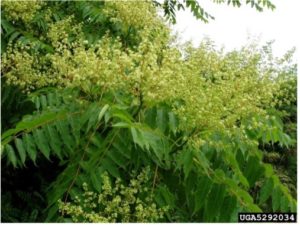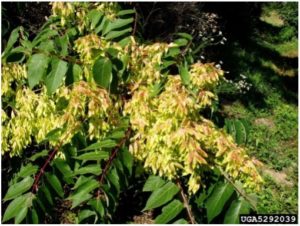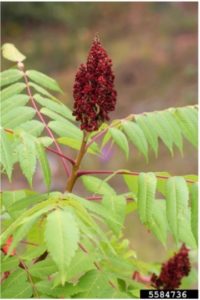
Take just a short drive down the road or interstate, and I bet you will have a good chance of seeing Tree-of-Heaven. In the last few years, I have really started to notice this tree along the sides of roads. I have also made numerous landowner visits where I have seen it on their property. Tree-of-Heaven can be found throughout much of the continental U.S., as indicated by figure 1. While it is native to Eastern China, it was introduced to the U.S. in 1784 from Europe as an ornamental.
Tree-of-Heaven is a rapidly growing tree that has the capability to form dense stands. It is also allelopathic, which means it creates a biochemical that can suppress other plant species’ germination, growth, and survival.

Image Source: Jan Samanek, Phytosanitary Administration, Bugwood.org
The tree can reach 80 feet in height and has long, pinnately compound leaves with circular glands under the lobes of the leaflet bases. The leaves are alternate with 10 to 41 leaflets on 1 to 3-foot stalks. To me, the leaves resemble those of sumac, except they can be much longer.
Tree-of-Heaven flowers between April and June. The flowers can be seen in figure 2. Typically, you will see long terminal clusters of small yellowish-green flowers. As seen in figure 3, the flowers produce seeds that can stay on the tree from July to February. The seed is where you can really notice the difference between Tree-of-Heaven and sumac as seen by the Tree-of-Heaven seed in figure 3 and sumac seed head in figure 4. The Tree-of-Heaven seed is very prolific and can be spread by wind and water. Tree-of-Heaven can also reproduce by root sprouts and resprouts previously from cut stumps.

Image Source: Jan Samanek, Phytosanitary Administration, Bugwood.org
Recommended Control Procedures:
Large trees: Make stem injections and then apply Garlon 3A, Pathway*, Pathfinder II, or Arsenal AC* in dilutions and cut spacings specified on the herbicide label (midsummer best, late winter somewhat less effective). For felled trees, apply these herbicides to stem and stump tops immediately after cutting.
Saplings: Apply Garlon 4 as a 20-percent solution in basal oil, vegetable oil, crop oil concentrate, diesel fuel, or kerosene (2.5 quarts per 3-gallon mix) or apply undiluted Pathfinder II to young bark as a basal spray.

Image Source: Steven Katovich, Bugwood.org
Seedlings and saplings: Thoroughly wet all leaves with one of the following herbicides in water with a surfactant (July to October): Arsenal AC* as a 1-percent solution (4 ounces per 3-gallon mix), Krenite S as a 15-percent solution (3 pints per 3-gallon mix), Garlon 4 as a 2-percent solution (8 ounces per 3-gallon mix), or Escort XP* at 1 ounce per acre.
Prescriptions used from Nonnative Invasive Plants of Southern Forest: A Field Guide for Identification and Control publication.
*Nontarget plants may be killed by root uptake
Author(s)
Jeff Fellers, Cooperative Extension, Forestry and Wildlife Agent
This information is supplied with the understanding that no discrimination is intended and no endorsement of brand names or registered trademarks by the Clemson University Cooperative Extension Service is implied, nor is any discrimination intended by the exclusion of products or manufacturers not named. All recommendations are for South Carolina conditions and may not apply to other areas. Use pesticides only according to the directions on the label. All recommendations for pesticide use are for South Carolina only and were legal at the time of publication, but the status of registration and use patterns are subject to change by action of state and federal regulatory agencies. Follow all directions, precautions and restrictions that are listed.
Clemson University Cooperative Extension Service offers its programs to people of all ages, regardless of race, color, gender, religion, national origin, disability, political beliefs, sexual orientation, gender identity, marital or family status and is an equal opportunity employer.
